Cisco 7911G, 7906G User Manual

Cisco Unified IP Phone 7906G and 7911G Phone Guide for Cisco Unified Communicatons Manager 6.0 (SCCP and SIP)
Americas Headquarters
Cisco Systems, Inc. 170 West Tasman Drive
San Jose, CA 95134-1706 USA http://www.cisco.com Tel: 408 526-4000
800 553-NETS (6387) Fax: 408 527-0883
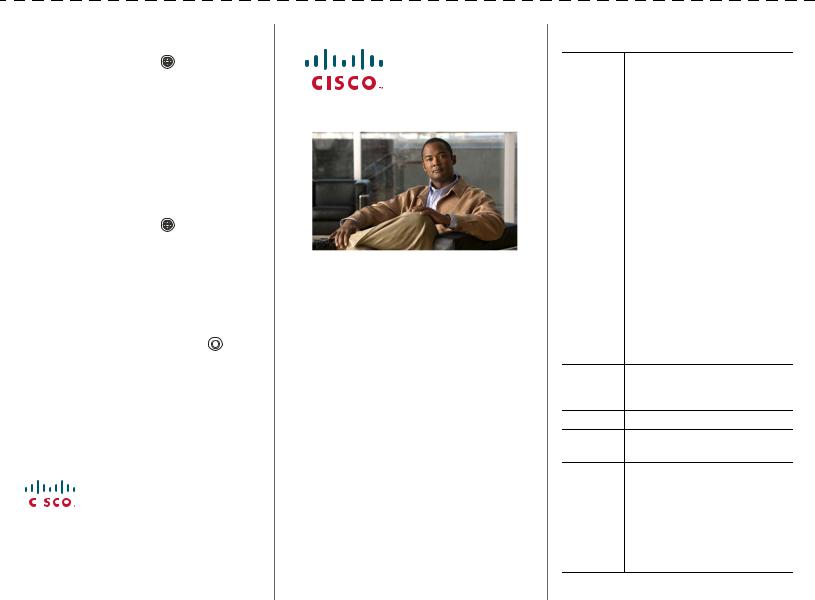
Common Phone Tasks
View online help |
Press |
and choose |
||
on the phone |
Help. |
|
|
|
|
|
|||
Place a call |
Go off-hook before or |
|||
|
|
after dialing a number. |
||
|
|
|
||
Redial a number |
Press Redial. |
|
||
|
|
|||
Talk using the |
(Group Listen mode |
|||
handset and listen |
only.) Press GListen. |
|||
on the speaker |
|
|
|
|
|
|
|||
Listen on the |
(Monitor mode only.) |
|||
speaker only |
Press Monitor. |
|
||
|
|
|
||
Use your call logs |
Press |
and select |
||
|
|
Directories > Missed |
||
|
|
Calls, Placed Calls, or |
||
|
|
Received Calls. Select a |
||
|
|
number and press Dial. |
||
|
|
|||
Edit a number |
Press EditDial, << or >>. |
|||
|
|
|||
Hold/resume a call |
Highlight a call to put on |
|||
|
|
hold or resume from |
||
|
|
hold, and press |
. |
|
|
|
|||
Transfer a call to a |
Press Transfer, enter the |
|||
new number |
number, then press |
|
||
|
|
Transfer again. |
|
|
|
|
|||
Start a standard |
Press more > Confrn and |
|||
(ad hoc) conference |
dial the participant, then |
|||
call |
press Confrn again. |
|
||
|
|
|
|
|
|
|
|
|
|
|
|
|
|
|
Cisco, Cisco Systems, and the Cisco Systems logo are registered trademarks or trademarks of Cisco Systems, Inc. and/or its affiliates in the United States and certain other countries. All other trademarks mentioned in this document or Website are the property of their respective owners. The use of the word partner does not imply a partnership relationship between Cisco and any other company. (0610R)
© 2007 Cisco Systems, Inc. All rights reserved.
OL-12474-01
QUICK REFERENCE
Cisco Unified IP Phone 7906G and 7911G for Cisco Unified Communications Manager 6.0
(SCCP and SIP)
Softkey Definitions
Phone Screen Icons
Button Icons
Speed Dialing
Common Phone Tasks
Softkey Definitions
AbbrDial |
Dial using a speed-dial index |
|
number |
|
|
Answer |
Answer a call |
|
|
Barge |
Add yourself to a call on a shared |
|
line |
|
|
CallBack |
Receive notification when a busy |
|
extension becomes available |
|
|
Cancel |
Cancel an action or exit a screen |
|
without applying changes |
|
|
cBarge |
Add yourself to a call on a shared |
|
line and establish a conference |
|
|
CFwdALL |
Setup/cancel call forwarding |
|
|
Clear |
Delete records or settings |
|
|
Close |
Close the current window |
|
|
ConfList |
View conference participants |
|
|
Confrn |
Create a conference call |
|
|
Delete |
Remove characters to the right of |
|
the cursor when using EditDial |
Details Opens the Details call record for a (SCCP only) multiparty call in the Missed Calls
and Received Calls logs
Dial Dial a phone number
DirTrfr Transfer two calls to each other (SCCP only)
DND |
Turn on/off Do Not Disturb |
|
(DND) |
|
|
EditDial |
Edit a number in a call log |
|
|
EndCall |
Disconnect the current call |
|
|
Erase |
Reset settings to their defaults |
|
|
Exit |
Return to the previous screen |

GListen |
Talk using the handset and listen |
|
on the speaker (Group Listen) |
|
|
GLOff |
Disable Group Listen |
|
|
GPickUp |
Answer a call ringing in another |
|
group |
|
|
iDivert |
Send or redirect a call to a voice |
|
message system |
|
|
Join |
Join several calls on a single line to |
(SCCP only) |
create a conference |
|
|
MeetMe |
Host a Meet-Me conference call |
|
|
Monitor |
Listen to a call on the speaker |
|
|
MonOff |
Disable the Monitor function |
|
|
more |
Display additional softkeys |
|
|
Msgs |
Access voice mail system |
|
|
New Call |
Make a new call |
|
|
OPickUp |
Answer a call ringing in an |
|
associated group |
|
|
Park |
Store a call using Call Park |
|
|
PickUp |
Answer a call in your group |
|
|
QRT |
Submit call problems to the system |
|
administrator |
|
|
Redial |
Redial the most recently dialed |
|
number |
|
|
Remove |
Remove a conference participant |
|
|
RMLstC |
Drop the last party added to a |
|
conference call |
|
|
Search |
Search for a directory listing |
|
|
Transfer |
Transfer a call |
|
|
Update |
Refresh content |
|
|
VidMode |
Choose a video display mode |
(SCCP only) |
|
|
|
<< |
Delete entered characters |
|
|
>> |
Move through entered characters |
|
|
Phone Screen Icons
Line and Call Status
Call Forwarding enabled
Call on hold
Connected call
Off-hook
On-hook
 Incoming call
Incoming call
Shared line in use
Authenticated call
Encrypted call
Priority call
Medium priority call
High priority call
Highest priority call
Other Features
Speed Dial configured
Message waiting
Option selected
Feature enabled
URL entry in call log is ready to edit (SIP only)
Audio or Video Mode
Handset in use
Speaker in use (Monitor on)
Video enabled (Cisco Unified
IP Phone 7911G only with SCCP)
Button Icons
Volume
Navigation
Hold
Applications Menu
Speed Dialing
If you want to... Then... |
|
||
|
|
|
|
Speed dial a |
• Press |
and select a |
|
number |
|||
number to dial. |
|||
|
|||
•Press  and choose
and choose
Directories > Speed Dials. Select a number to dial.
•Enter a speed-dial number while on-hook and press AbbrDial.

Contents
Getting Started 1
Using this Guide 1
Finding Additional Information 2
Safety and Performance Information 2
Cisco Product Security Overview 3
Accessibility Features 3
Connecting Your Phone 4
An Overview of Your Phone 8
Understanding Buttons and Hardware 8
Understanding Lines vs. Calls 10
Understanding Line and Call Icons 10
Accessing Applications Menus 10
Accessing the Help System on Your Phone 11
Understanding Feature Availability |
11 |
Understanding SIP vs. SCCP 11 |
|
Basic Call Handling 12 |
|
Placing a Call—Basic Options 12 |
|
Placing a Call—Additional Options |
13 |
Answering a Call 14 |
|
Ending a Call 15 |
|
Using Hold and Resume 16 |
|
Switching Between Multiple Calls |
17 |
Switching an In-Progress Call to Another Phone 17
Viewing Multiple Calls 17
Cisco Unified IP Phone 7906G and 7911G for Cisco Unified Communications Manager 6.0 |
v |
Transferring Calls 18
Sending a Call to a Voice Message System 19
Forwarding All Calls to Another Number 20
Using Do Not Disturb 20
Making Conference Calls 21
Understanding Types of Conference Calls 21
Starting and Joining a Standard Conference 22
Starting or Joining a Meet-Me Conference Call 24
Advanced Call Handling 25
Speed Dialing 25
Picking Up a Redirected Call on Your Phone 26
Storing and Retrieving Parked Calls 27
Logging Out of Hunt Groups 27
Using a Shared Line 28
Understanding Shared Lines 28
Adding Yourself to a Shared-Line Call 29
Preventing Others from Viewing or Barging a Shared-Line Call 30
Making and Receiving Secure Calls 30
Tracing Suspicious Calls 31
Prioritizing Critical Calls 32
Using Cisco Extension Mobility 33
Managing Business Calls Using a Single Phone Number 34
Using a Handset, Headset, and Speaker 36
Using the Group Listen Feature 36
Using the Monitor Feature 37
Using and Obtaining a Headset 38
Using AutoAnswer 38
Changing Phone Settings 39
Customizing Rings and Message Indicators 39
Customizing the Phone Screen 40
vi |
OL-12474-01 |
Using Call Logs and Directories 41 |
|
|
|
|
|
Using Call Logs |
41 |
|
|
|
|
Directory Dialing |
43 |
|
|
|
|
Using Corporate Directory on Your Phone |
43 |
|
|
||
Using Personal Directory on Your Phone |
44 |
|
|
||
Accessing Voice Messages 47 |
|
|
|
|
|
Using the User Options Web Pages 48 |
|
|
|
||
Accessing Your User Options Web Pages |
48 |
|
|
|
|
Configuring Features and Services on the Web 49 |
|
|
|||
Using Personal Directory on the Web |
49 |
|
|
|
|
Using Your Personal Address Book on the Web |
49 |
||||
Configuring Fast Dials on the Web |
50 |
|
|
||
Using the Address Book Synchronization Tool |
51 |
|
|||
Setting Up Speed Dials on the Web 51 |
|
|
|
||
Setting Up Phone Services on the Web |
52 |
|
|
||
Controlling User Settings on the Web |
53 |
|
|
|
|
Controlling Line Settings on the Web |
54 |
|
|
|
|
Using Cisco WebDialer 55 |
|
|
|
|
|
Setting Up Phones and Access Lists for Mobile Connect |
57 |
||||
Understanding Additional Configuration Options |
60 |
||||
Troubleshooting Your Phone 61 |
|
|
|
|
|
General Troubleshooting 61 |
|
|
|
|
|
Viewing Phone Administration Data 62 |
|
|
|
|
|
Using the Quality Reporting Tool 62 |
|
|
|
|
|
Cisco One-Year Limited Hardware Warranty Terms |
63 |
||||
Index 65
Cisco Unified IP Phone 7906G and 7911G for Cisco Unified Communications Manager 6.0 |
vii |
viii |
OL-12474-01 |

Getting Started
Using this Guide
This guide provides you with an overview of the features available on your phone. You can read it completely for a solid understanding of your phone’s capabilities, or refer to the table below for pointers to commonly-used sections.
If you want to... |
Then... |
|
|
|
|
Explore your phone on your own |
Press |
and choose Help. |
|
|
|
Review safety information |
See Safety and Performance Information, page 2. |
|
|
|
|
Connect your phone |
See Connecting Your Phone, page 4. |
|
|
|
|
Use your phone after it is installed |
Start with An Overview of Your Phone, page 8. |
|
|
|
|
Learn about the phone buttons |
See Understanding Buttons and Hardware, page 8. |
|
|
|
|
Make calls |
See Placing a Call—Basic Options, page 12. |
|
|
|
|
Put calls on hold |
See Using Hold and Resume, page 16. |
|
|
|
|
Transfer calls |
See Transferring Calls, page 18. |
|
|
|
|
Make conference calls |
See Making Conference Calls, page 21. |
|
|
|
|
Set up speed dialing |
See Speed Dialing, page 25. |
|
|
|
|
Share a phone number |
See Using a Shared Line, page 28. |
|
|
|
|
Use the speaker on the phone |
See Using a Handset, Headset, and Speaker, page 36. |
|
|
|
|
Change the ring volume or tone |
See Changing Phone Settings, page 39. |
|
|
|
|
View your missed calls |
See Using Call Logs and Directories, page 41. |
|
|
|
|
Listen to your voice messages |
See Accessing Voice Messages, page 47. |
|
|
|
|
See softkey and icon definitions |
Refer to the Quick Reference Card in the front of this guide. |
|
|
|
|
Cisco Unified IP Phone 7906G and 7911G for Cisco Unified Communications Manager 6.0 |
1 |
Finding Additional Information
You can access the most current Cisco documentation on the World Wide Web at this URL:
http://www.cisco.com/en/US/products/hw/phones/ps379/tsd_products_support_series_home.htm
You can access the Cisco website at this URL:
http://www.cisco.com/
International Cisco websites can be accessed from this URL:
http://www.cisco.com/public/countries_languages.shtml
Safety and Performance Information
Refer to these sections for information about the impact of power outages and other devices on your Cisco Unified IP Phone.
Power Outage
Your accessibility to emergency service through the phone is dependent on the phone being powered. If there is an interruption in the power supply, Service and Emergency Calling Service dialing will not function until power is restored. In the case of a power failure or disruption, you may need to reset or reconfigure equipment before using the Service or Emergency Calling Service dialing.
Using External Devices
The following information applies when you use external devices with the Cisco Unified IP Phone:
Cisco recommends the use of good quality external devices (headsets) that are shielded against unwanted radio frequency (RF) and audio frequency (AF) signals.
Depending on the quality of these devices and their proximity to other devices such as mobile phones or two-way radios, some audio noise may still occur. In these cases, Cisco recommends that you take one or more of the following actions:
•Move the external device away from the source of the RF or AF signals.
•Route the external device cables away from the source of the RF or AF signals.
•Use shielded cables for the external device, or use cables with a better shield and connector.
•Shorten the length of the external device cable.
•Apply ferrites or other such devices on the cables for the external device.
Cisco cannot guarantee the performance of the system because Cisco has no control over the quality of external devices, cables, and connectors. The system will perform adequately when suitable devices are attached using good quality cables and connectors.
2 |
OL-12474-01 |

Getting Started
Caution In European Union countries, use only headsets that are fully compliant with the EMC Directive [89/336/EC].
Cisco Product Security Overview
This product contains cryptographic features and is subject to United States and local country laws governing import, export, transfer and use. Delivery of Cisco cryptographic products does not imply third-party authority to import, export, distribute or use encryption. Importers, exporters, distributors and users are responsible for compliance with U.S. and local country laws. By using this product you agree to comply with applicable laws and regulations. If you are unable to comply with U.S. and local laws, return this product immediately.
A summary of U.S. laws governing Cisco cryptographic products may be found at: http://www.cisco.com/wwl/export/crypto/tool/stqrg.html. If you require further assistance please contact us by sending email to export@cisco.com.
Accessibility Features
A list of accessibility features is available upon request.
Cisco Unified IP Phone 7906G and 7911G for Cisco Unified Communications Manager 6.0 |
3 |

Connecting Your Phone
Your system administrator will likely connect your new Cisco Unified IP Phone to the corporate IP telephony network. If that is not the case, refer to the graphics below to connect your phone.
The following graphic and table show how to connect the Cisco Unified IP Phone 7906G:
3
|
5 |
1 |
4 |
79976
1 |
Network port (10/100 SW) |
4 |
AC-to-DC power supply |
|
|
|
|
2 |
Handset port |
5 |
AC power cord |
|
|
|
|
3 |
DC adapter port (DC48V) |
|
|
|
|
|
|
4 |
OL-12474-01 |
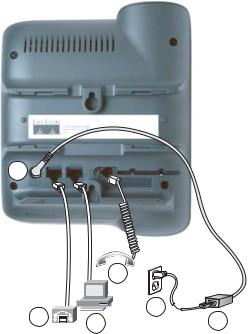
Connecting Your Phone
The following graphic and table show how to connect the Cisco Unified IP Phone 7911G:
4
3
6
|
1 |
|
|
5 |
91638 |
|
|
|
2 |
|
|
||||
|
|
|
|
||||
|
|
|
|
|
|||
|
|
|
|
|
|
|
|
1 |
Network port (10/100 SW) |
|
|
4 |
DC adapter port (DC48V) |
||
|
|
|
|
|
|
|
|
2 |
Access port (10/100 PC) |
|
|
5 |
AC-to-DC power supply |
||
|
|
|
|
|
|
|
|
3 |
Handset port |
|
|
6 |
AC power cord |
||
|
|
|
|
|
|
|
|
Cisco Unified IP Phone 7906G and 7911G for Cisco Unified Communications Manager 6.0 |
5 |
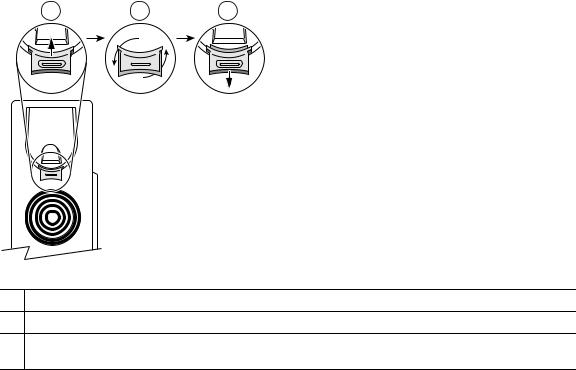
Adjusting the Handset Rest
When you connect your phone, you might want to adjust the handset rest to ensure that the receiver will not slip out of the cradle. See the table below for instructions.
1 |
2 |
3 |
77354
1Set the handset aside and pull the square plastic tab from the handset rest.
2Rotate the tab 180 degrees.
3Slide the tab back into the handset rest. An extension protrudes from the top of the rotated tab. Return the handset to the handset rest.
Registering with TAPS
After your phone is connected to the network, your system administrator might ask you to auto-register your phone using the Tool for Auto-Registered Phones Support (TAPS). TAPS might be used either for a new phone or to replace an existing phone.
To register with TAPS, pick up the handset, enter the TAPS extension provided by your system administrator, and follow the voice prompts. You might need to enter your entire extension, including the area code. After your phone displays a confirmation message, hang up. The phone will restart.
Headset Information
To use a headset, make sure the handset is disconnected, then connect the headset to the Handset port on the back of your phone.
Depending on headset manufacturer’s recommendations, an external amplifier may be required. Refer to headset manufacturer’s product documentation for more information.
6 |
OL-12474-01 |
Connecting Your Phone
Although Cisco Systems performs some internal testing of third-party headsets for use with the Cisco Unified IP Phones, Cisco does not certify or support products from headset or handset vendors. Because of the inherent environmental and hardware inconsistencies in the locations where
Cisco Unified IP Phones are deployed, there is not a single “best” solution that is optimal for all environments. Cisco recommends that customers test the headsets that work best in their environment before deploying a large number of units in their network.
In some instances, the mechanics or electronics of various headsets can cause remote parties to hear an echo of their own voice when they speak to Cisco Unified IP Phone users.
Cisco Systems recommends the use of good quality external devices (headsets) that are screened against unwanted radio frequency (RF) and audio frequency (AF) signals. Depending on the quality of these devices and their proximity to other devices such as cell phones and two-way radios, some audio noise may still occur.
The primary reason that support of a headset would be inappropriate for the Cisco Unified IP Phone is the potential for an audible hum. This hum can either be heard by the remote party or by both the remote party and you, the Cisco Unified IP Phone user. Some potential humming or buzzing sounds can be caused by a range of outside sources, for example, electric lights, being near electric motors, large PC monitors. In some cases, a hum experienced by a user may be reduced or eliminated by using a local power cube or power injector.
Audio Quality Subjective to the User
Beyond the physical, mechanical and technical performance, the audio portion of a headset must sound good to you (the user) and to the party on the far end. Sound is subjective and Cisco cannot guarantee the performance of any headsets or handsets, but some of the headsets and handsets on the sites listed below have been reported to perform well with Cisco Unified IP Phones.
Nevertheless, it is ultimately still the customer’s responsibility to test this equipment in their own environment to determine suitable performance.
For information about headsets, see:
http://www.vxicorp.com/cisco
http://www.plantronics.com
http://www.jabra.com
Cisco Unified IP Phone 7906G and 7911G for Cisco Unified Communications Manager 6.0 |
7 |
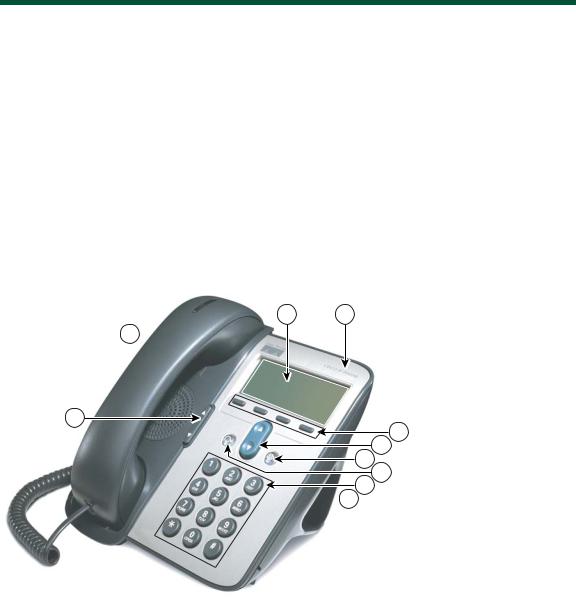
An Overview of Your Phone
Cisco Unified IP Phone 7906G and 7911G are full-feature telephones that provide voice communication over the same data network that your computer uses, allowing you to place and receive calls, put calls on hold, transfer calls, make conference calls, and so on.
In addition to basic call-handling features, your Cisco Unified IP Phone 7906G and 7911G can provide specialized or advanced telephony features that extend your call-handling capabilities. Depending on configuration, your phone supports:
•Access to network data, XML applications, and web-based services.
•Online customizing of phone features and services from your User Options web pages.
Understanding Buttons and Hardware
You can use this graphic below to identify the buttons and hardware on your phone.
1 2
9 
8
3
4
5
6
7
 10
10
91031
8 |
OL-12474-01 |

|
|
|
An Overview of Your Phone |
|
|
|
|
|
|
|
For more information, |
|
Item |
Description |
see... |
|
|
|
|
1 |
Phone screen |
Displays phone menus and call activity |
Accessing Applications |
|
|
including caller ID, call duration, and call state. |
Menus, page 10 and |
|
|
|
Understanding Feature |
|
|
|
Availability, page 11. |
|
|
|
|
2 |
Cisco Unified IP |
Indicates your Cisco Unified IP Phone model |
— |
|
Phone series |
series. |
|
|
|
|
|
3 |
Softkey buttons |
Each activates a softkey option displayed on |
Softkey Definitions, |
|
|
your phone screen. |
page 3. |
|
|
|
|
4 |
Navigation button |
Allows you to scroll through menu items and |
Accessing Applications |
|
|
highlight items. When the phone is on-hook, |
Menus, page 10 and |
|
|
displays your Speed Dials. |
Speed Dialing, page 25. |
|
|
|
|
5 |
Applications Menu |
Displays the Applications menu that provides |
Accessing Applications |
|
button |
access to a voice message system, phone logs |
Menus, page 10. |
|
|
and directories, settings, services, and help. |
|
|
|
|
|
6 |
Hold button |
Places the active call on hold, resumes a call on |
Using Hold and |
|
|
hold, and switches between an active call and a |
Resume, page 16. |
|
|
call on hold. |
|
|
|
|
|
7 |
Keypad |
Allows you to dial phone numbers, enter |
Basic Call Handling, |
|
|
letters, and choose menu items. |
page 12. |
|
|
|
|
8 |
Volume button |
Controls the handset, headset, speaker, and |
Using a Handset, |
|
|
ringer volume. |
Headset, and Speaker, |
|
|
|
page 36. |
|
|
|
|
9 |
Handset with light |
The light strip on the handset indicates an |
Accessing Voice |
|
strip |
incoming call or new voice message. |
Messages, page 47. |
|
|
|
|
10 |
Footstand |
Allows the phone to stand at a convenient angle |
— |
|
|
on a desk or table. |
|
|
|
|
|
Cisco Unified IP Phone 7906G and 7911G for Cisco Unified Communications Manager 6.0 |
9 |
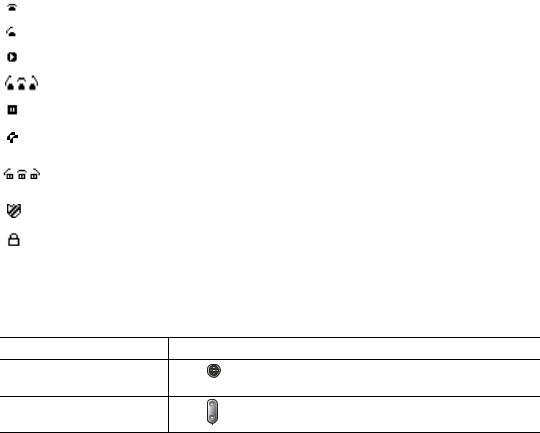
Understanding Lines vs. Calls
To avoid confusion about lines and calls, refer to these descriptions:
•Lines—Each line corresponds to a phone number (or extension) that others can use to call you. Your phone can support one line.
•Calls—Each line can support multiple calls. By default, your phone supports up to six connected calls, but your system administrator can adjust this number according to your needs. Only one call can be active at any time; other calls are automatically placed on hold.
Understanding Line and Call Icons
Your phone displays icons to help you determine the call and line state (on-hook, on hold, ringing, connected, and so on).
Icon |
Call or line state |
Description |
|
|
|
|
On-hook line |
No call activity on this line. |
|
|
|
|
Off-hook line |
You are dialing a number or an outgoing call is ringing. |
|
|
|
|
Connected call |
You are connected to the other party. |
|
|
|
|
Ringing call |
A call is ringing on your line. |
|
|
|
|
Call on hold |
You have put this call on hold. See Using Hold and Resume, page 16. |
|
|
|
|
Remote-in-use |
Another phone that shares your line has a connected call. See |
|
|
Understanding Shared Lines, page 28. |
|
|
|
|
Reverting call |
A holding call is reverting to your phone. See Using Hold and Resume, |
|
|
page 16. |
|
|
|
|
Authenticated call |
See Making and Receiving Secure Calls, page 30. |
|
|
|
|
Encrypted call |
See Making and Receiving Secure Calls, page 30. |
|
|
|
Accessing Applications Menus
Use the Applications menus to access phone features.
If you want to... |
Then... |
|
Access the Applications |
Press |
to display a list of Applications: Messages, Directory, |
menus |
Settings, Services, and Help. |
|
Scroll through a list or |
Press |
. |
menu |
|
|
10 |
|
OL-12474-01 |

|
|
An Overview of Your Phone |
||
|
|
|
|
|
If you want to... |
Then... |
|
|
|
|
|
|
|
|
Select a menu item |
Press |
to highlight a menu item, then press Select. |
|
|
|
You can also press the number on the keypad that corresponds |
|
|
|
|
to the number for the menu item. |
|
|
|
|
|
|
|
|
Go back one level in a menu |
Press Exit. (Note that if you press Exit from the top-level of a |
|
|
|
|
menu, the menu will close.) |
|
|
|
|
|
|
|
|
Close a menu (and return to |
Press Exit one or more times until the menu closes, or press |
. |
|
|
the Applications menu) |
|
|
|
|
|
|
|
|
|
Exit the Applications menu |
Press |
or Exit. |
|
|
|
|
|
|
|
Note After you press  , the LED turns green and stays lit while you are using the Applications menus. If you depart from an application without pressing
, the LED turns green and stays lit while you are using the Applications menus. If you depart from an application without pressing  or Exit (for example, to answer a new call), the phone screen display may change but the
or Exit (for example, to answer a new call), the phone screen display may change but the  button stays green. If you press
button stays green. If you press  again, the application that you were using resumes at the point when it was interrupted.
again, the application that you were using resumes at the point when it was interrupted.
Accessing the Help System on Your Phone
The Cisco Unified IP Phone 7906G and 7911G provide a comprehensive online help system. To view the phone help, press  and choose Help.
and choose Help.
Understanding Feature Availability
Depending on your phone system configuration, features included in this Phone Guide might not be available to you or might work differently on your phone. Contact your support desk or system administrator for information about feature operation or availability.
Understanding SIP vs. SCCP
Your phone can be configured to work with one of two signaling protocols: SIP (Session Initiation Protocol) or SCCP (Skinny Call Control Protocol). Your system administrator determines this configuration.
Phone features can vary depending on the protocol. This Phone Guide indicates which features are protocol-specific. To learn which protocol your phone is using, you can ask your system administrator or you can choose  > Model Information > Call Control Protocol on your phone.
> Model Information > Call Control Protocol on your phone.
Cisco Unified IP Phone 7906G and 7911G for Cisco Unified Communications Manager 6.0 |
11 |

Basic Call Handling
You can perform basic call-handling tasks using a range of features and services. Feature availability can vary; see your system administrator for more information.
Placing a Call—Basic Options
Here are some easy ways to place a call on your Cisco Unified IP Phone.
|
|
|
|
For more information, |
If you want to... |
Then... |
|
see... |
|
|
|
|
||
Place a call |
Pick up the handset and dial the number. |
An Overview of Your |
||
|
|
|
|
Phone, page 8. |
|
|
|
||
Dial on-hook (with dial |
Press New Call and dial the number. |
— |
||
tone) |
|
|
|
|
|
|
|
|
|
Redial a number |
Press Redial. |
|
— |
|
|
|
|
|
|
Place a call when |
1. |
Press |
. |
Using Hold and |
another call is active |
2. |
Press New Call. |
Resume, page 16. |
|
|
|
|||
|
3. |
Enter a number. |
|
|
|
|
|
|
|
Dial from a call log |
1. |
Press |
and select Directories > Missed |
Using Call Logs, |
|
|
Calls, Received Calls, or Placed Calls. |
page 41. |
|
|
2. |
Scroll to the number and press Dial. |
|
|
|
|
|
|
|
Tips
•You can dial on-hook without a dial tone (pre-dial). To pre-dial, enter a number, then go off-hook by lifting the handset and press Dial.
•When you pre-dial, your phone tries to anticipate the number you are dialing by displaying matching numbers (if available) from your Placed Calls log. This is called Auto Dial. To call a number displayed with Auto Dial, scroll to it, press Dial, and go off-hook.
•If you make a mistake while dialing, press << to erase digits.
•If parties on a call hear a beep tone, the call might be monitored or recorded. Ask your system administrator for more information.
12 |
OL-12474-01 |

Basic Call Handling
Placing a Call—Additional Options
You can place calls using special features and services that might be available on your phone. See your system administrator for more information about these additional options.
|
|
|
|
For more information, |
If you want to... |
Then... |
|
see... |
|
|
|
|
||
Speed dial a number |
Do one of the following: |
Speed Dialing, page 25. |
||
|
• |
Press |
, choose a speed-dial number, |
|
|
|
and press Dial. |
|
|
|
• |
Press |
and select Directories > |
|
|
|
Speed Dials. Select a number and press |
|
|
|
|
Dial. |
|
|
|
• |
Use the Abbreviated Dial feature. |
|
|
|
• |
Use the Fast Dial feature. |
|
|
|
|
|
|
|
Dial from a corporate |
1. |
Press |
and select Directories > |
Using Call Logs, |
directory on your phone |
|
Corporate Directory (name can vary). |
page 41. |
|
|
2. |
Enter a name and press Search. |
|
|
|
3. |
Highlight a listing and go off-hook. |
|
|
|
|
|
|
|
Dial from a corporate |
1. |
Open a web browser and go to a |
Using |
|
directory on your personal |
|
WebDialer-enabled corporate |
Cisco WebDialer, |
|
computer using |
|
directory. |
page 55. |
|
Cisco WebDialer |
2. |
Click the number that you want to |
|
|
|
|
|||
|
|
dial. |
|
|
|
|
|
|
|
Use Cisco CallBack to receive |
1. |
Press CallBack while listening to the |
Your system |
|
notification when a busy or |
|
busy tone or ring sound. |
administrator. |
|
ringing extension is available |
2. |
Hang up. Your phone alerts you when |
|
|
|
|
|||
|
|
the line is free. |
|
|
|
3. |
Place the call again. |
|
|
|
|
|
||
Make a priority (precedence) |
Enter the Multilevel Precedence and |
Prioritizing Critical |
||
call (SCCP phones only) |
Preemption (MLPP) access number, then |
Calls, page 32. |
||
|
enter a phone number. |
|
||
|
|
|
|
|
Dial from a Personal Address |
1. |
Press |
and select Directories > |
Using the User Options |
Book (PAB) entry |
|
Personal Directory to log in. |
Web Pages, page 48. |
|
|
2. |
Choose Personal Address Book and |
Using Personal |
|
|
|
search for a listing. |
Directory on Your |
|
|
|
|
|
Phone, page 44. |
|
|
|
|
|
Cisco Unified IP Phone 7906G and 7911G for Cisco Unified Communications Manager 6.0 |
13 |
|
|
|
For more information, |
If you want to... |
Then... |
see... |
|
|
|
|
|
Place a call using a billing or |
1. |
Dial a number. |
Your system |
tracking code |
2. |
After the tone, enter a client matter |
administrator. |
|
|
||
(SCCP phones only) |
|
code (CMC) or a forced authorization |
|
|
|
code (FAC). |
|
|
|
|
|
Place a call using your Cisco |
Log in to the Cisco Extension Mobility |
Using Cisco Extension |
|
Extension Mobility profile |
service on a phone. |
Mobility, page 33. |
|
|
|
|
|
Make a call from a cellular |
1. |
Dial your assigned Mobile Voice |
Managing Business |
phone using Mobile Voice |
|
access number. |
Calls Using a Single |
Access |
2. |
Enter your cellular phone number (if |
Phone Number, |
|
page 34. |
||
|
|
requested) and PIN. |
|
|
|
|
|
|
3. |
Press 1 to make a call to an enterprise |
|
|
|
IP phone. |
|
|
4. |
Dial a desktop phone number other |
|
|
|
than your desktop phone number. |
|
|
|
|
|
Tip
Obtain this information from your system administrator before using Mobile Voice Access to make a call:
•Mobile Voice Access number
•End user PIN
Answering a Call
You can answer a call by simply lifting the handset, or you can use other options if they are available on your phone.
If you want to... |
Then... |
For more information, see... |
|
|
|
Switch from a connected |
Press Answer. |
Using Hold and Resume, page 16. |
call to answer a new call |
|
|
|
|
|
Answer a call using call |
Press Answer. |
Using Hold and Resume, page 16. |
waiting |
|
|
|
|
|
Send a call to a voice |
Press iDivert. |
Sending a Call to a Voice Message |
message system |
|
System, page 19. |
|
|
|
Automatically connect |
Use AutoAnswer. |
Using AutoAnswer, page 38. |
incoming calls |
|
|
|
|
|
14 |
|
OL-12474-01 |
|
|
Basic Call Handling |
|
|
|
If you want to... |
Then... |
For more information, see... |
|
|
|
Retrieve a parked call on |
Use Call Park or Directed Call Park. |
Storing and Retrieving Parked |
another phone |
|
Calls, page 27. |
|
|
|
Use your phone to answer |
Use Call Pickup. |
Picking Up a Redirected Call on |
a call ringing elsewhere |
|
Your Phone, page 26. |
|
|
|
Answer a priority call |
Hang up the current call and press |
Prioritizing Critical Calls, |
(SCCP phones only) |
Answer. |
page 32. |
|
|
|
Answer a call on your |
Set up Mobile Connect and answer |
Managing Business Calls Using a |
cellular phone or other |
your phone. |
Single Phone Number, page 34. |
remote destination |
When you enable Mobile Connect: |
|
|
|
|
|
• Your desktop and remote |
|
|
destinations receive calls |
|
|
simultaneously. |
|
|
• When you answer the call on |
|
|
your desktop phone, the remote |
|
|
destinations stop ringing, are |
|
|
disconnected, and display a |
|
|
missed call message. |
|
|
• When you answer the call on |
|
|
one remote destination, the |
|
|
other remote destinations stop |
|
|
ringing, are disconnected, and a |
|
|
missed call message is shown on |
|
|
the other remote destinations. |
|
|
|
|
Tip
If parties on a call hear a beep tone, the call might be monitored or recorded. Ask your system administrator for more information.
Ending a Call
To end a call, simply hang up. Here are some more details.
If you want to... |
Then... |
|
|
|
|
Hang up while using the handset |
Return the handset to its cradle. Or press EndCall. |
|
|
|
|
Hang up while monitoring a call (using |
Press EndCall. |
|
the speaker) |
|
|
|
|
|
Hang up one call, but preserve another |
Press EndCall. If necessary, remove the call from hold first. |
|
call on the same line |
|
|
|
|
|
Cisco Unified IP Phone 7906G and 7911G for Cisco Unified Communications Manager 6.0 |
15 |
|

Using Hold and Resume
You can hold and resume calls. When you put a call on hold, the Hold icon  appears next to the caller ID and the Hold button
appears next to the caller ID and the Hold button  becomes lit (red).
becomes lit (red).
If the Hold Reversion feature is enabled for your phone, calls that you leave on hold will revert back to ringing on your phone after a certain length of time. These “reverting” calls remain on hold until you resume them.
Your phone indicates the presence of a reverting call by:
•Alerting you at intervals with a single ring (or flash or beep, depending on your phone line setting).
•Briefly displaying a “Hold Reversion” message in the status bar at the bottom of the phone screen.
•Displaying the animated Hold Reversion icon  next to the caller ID for the held call.
next to the caller ID for the held call.
If you want to... |
Then... |
|
|
|
|
|
|
Put a call on hold |
1. |
Make sure the call you want to put on hold is highlighted. |
|
|
2. |
Press |
. |
|
|
|
|
Remove a call from hold |
1. |
Make sure the appropriate call is highlighted. |
|
|
2. |
Press |
. |
|
|
|
|
Tips
•Engaging the Hold feature typically generates music or a beeping tone.
•When a held call is highlighted, the Hold button  becomes lit (red). When a call that is not held is highlighted, and there are other held calls on the line, the Hold button changes to blinking (red).
becomes lit (red). When a call that is not held is highlighted, and there are other held calls on the line, the Hold button changes to blinking (red).
•If you receive an alert for an incoming call and a reverting call at the same time, by default your phone will shift the focus of the phone screen to display the incoming call. Your system administrator can change this focus priority setting.
•If you use a shared line, Hold Reversion rings only on the phone that put the call on hold, not on the other phones that share the line.
•The duration between Hold Reversion alerts is determined by your system administrator.
16 |
OL-12474-01 |
